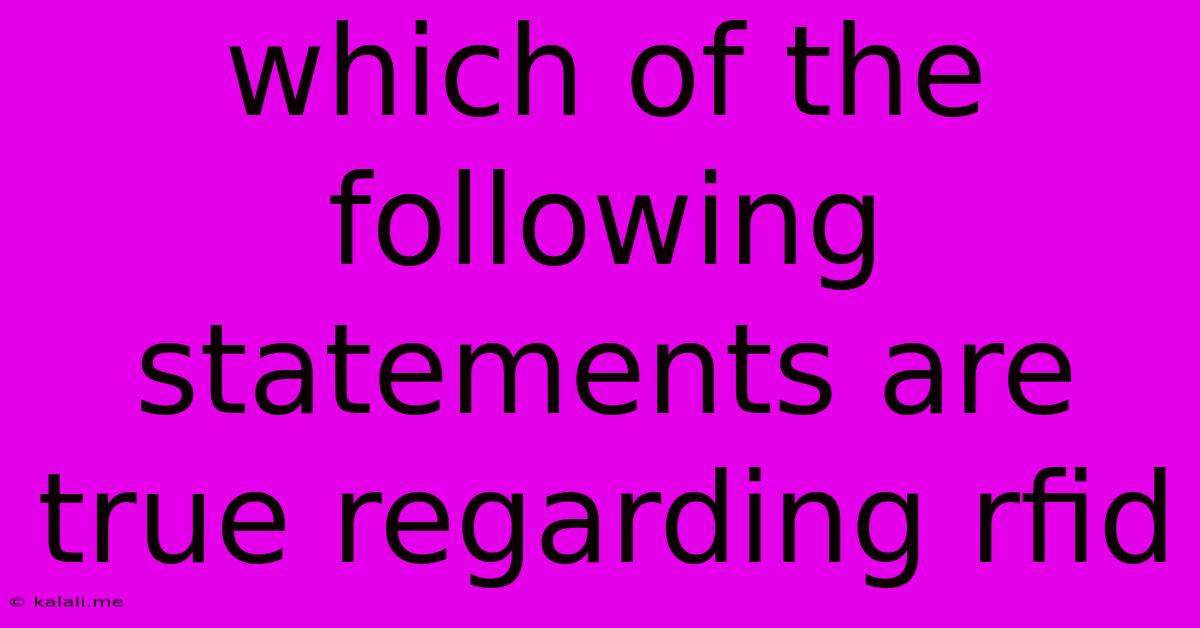Which Of The Following Statements Are True Regarding Rfid
Kalali
Jun 13, 2025 · 3 min read

Table of Contents
Which of the following statements are true regarding RFID? A Comprehensive Guide
This article will explore the common statements regarding Radio-Frequency Identification (RFID) technology and determine their accuracy. RFID is a powerful technology used in numerous applications, from supply chain management to access control, and understanding its capabilities and limitations is crucial. This guide will help you separate fact from fiction when it comes to RFID.
What is RFID?
Before diving into the true and false statements, let's briefly define RFID. RFID uses radio waves to automatically identify and track tags attached to objects. These tags contain electronically stored information, and a reader uses radio waves to capture this data wirelessly. The system typically consists of three components: tags, readers, and antennas. Understanding these core components is fundamental to grasping the nuances of RFID technology.
Common Statements about RFID: Fact or Fiction?
Let's examine some common assertions about RFID technology:
Statement 1: RFID tags require line-of-sight for reading.
FALSE. Unlike barcodes or QR codes, RFID tags do not require a direct line of sight between the tag and the reader. Radio waves can penetrate various materials, allowing readers to identify tags even if they are obscured by packaging, liquids, or other obstacles. This is a key advantage of RFID over other identification technologies. The ability to read multiple tags simultaneously further enhances its efficiency.
Statement 2: RFID technology is only used for inventory management.
FALSE. While inventory management is a significant application of RFID, its uses extend far beyond that. RFID finds application in numerous sectors, including:
- Access control: Key cards and building security systems.
- Animal tracking: Monitoring livestock and wildlife populations.
- Healthcare: Patient identification and tracking medical equipment.
- Payment systems: Contactless payment cards.
- Supply chain visibility: Tracking goods throughout the supply chain.
- Anti-theft measures: Preventing shoplifting and product theft.
Statement 3: RFID tags are expensive.
Partially TRUE. The cost of RFID tags varies significantly depending on the type of tag, its features (such as memory capacity and read range), and the quantity purchased. While some high-performance tags can be relatively expensive, the cost of simpler passive tags has decreased significantly, making them affordable for a wide range of applications.
Statement 4: RFID technology is prone to security vulnerabilities.
TRUE. Like any wireless technology, RFID systems are susceptible to security threats. Unauthorized access, data breaches, and cloning are potential concerns. Implementing robust security measures, such as encryption and authentication protocols, is crucial to mitigate these risks.
Statement 5: RFID can be used to track individuals without their knowledge.
TRUE. While ethical concerns exist, passive RFID tags can be embedded in everyday items without the user's explicit knowledge or consent. However, regulations and privacy laws are increasingly addressing these concerns.
Conclusion:
RFID technology offers significant advantages in terms of efficiency, automation, and data accuracy. However, it's crucial to understand both its strengths and limitations, including potential security vulnerabilities and privacy implications. This comprehensive guide has helped clarify some common misconceptions and provided a more nuanced understanding of RFID's capabilities and limitations. By understanding these factors, businesses and individuals can leverage the benefits of RFID technology responsibly and effectively.
Latest Posts
Latest Posts
-
What Is The Lcm Of 4 6 And 9
Jun 14, 2025
-
Which Of The Following Is Not A Reducing Sugar
Jun 14, 2025
-
What Is The Equivalent Capacitance Of The Combination Shown
Jun 14, 2025
-
An Item Is Considered Material If
Jun 14, 2025
-
Genders Are An Example Of Which Type Of Data
Jun 14, 2025
Related Post
Thank you for visiting our website which covers about Which Of The Following Statements Are True Regarding Rfid . We hope the information provided has been useful to you. Feel free to contact us if you have any questions or need further assistance. See you next time and don't miss to bookmark.